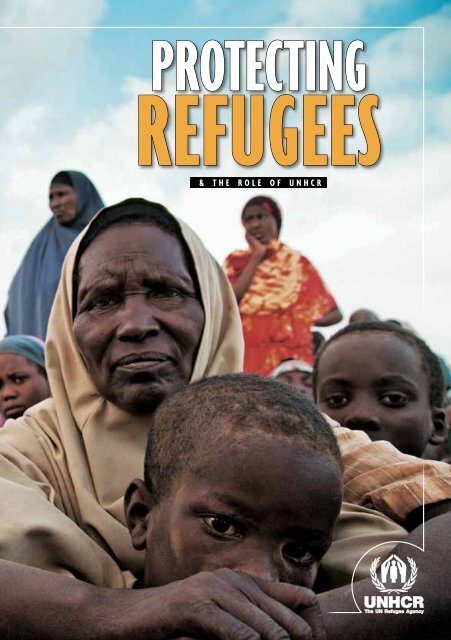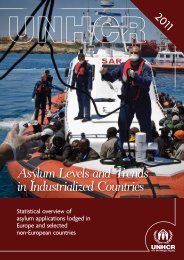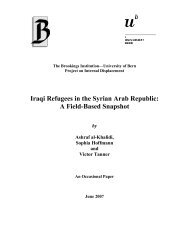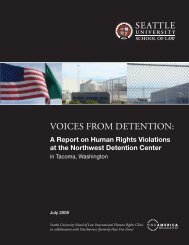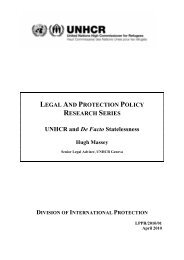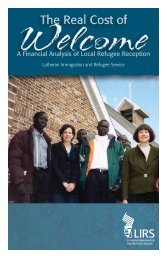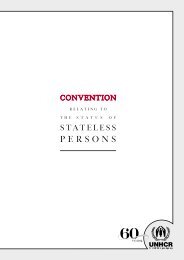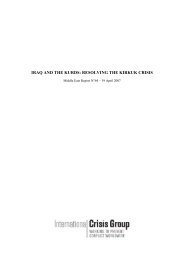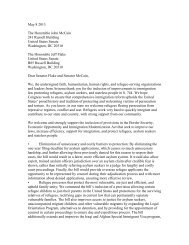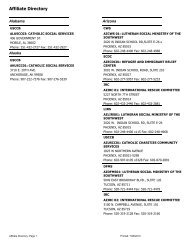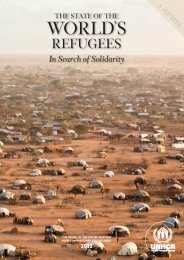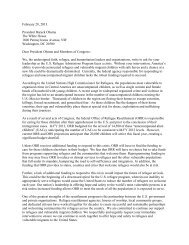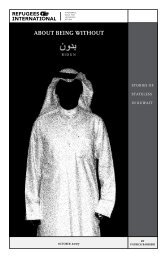& the role of UNhCr
& the role of UNhCr
& the role of UNhCr
Create successful ePaper yourself
Turn your PDF publications into a flip-book with our unique Google optimized e-Paper software.
PROTECTING<br />
REFUGEES<br />
& <strong>the</strong> <strong>role</strong> <strong>of</strong> UNHCR
An Afghan refugee<br />
working with a moulding<br />
machine, provided by<br />
UNHCR in 2009.
PROTECTING<br />
REFUGEES<br />
& <strong>the</strong> <strong>role</strong> <strong>of</strong> UNHCR<br />
Cover:<br />
This woman<br />
fled Somalia<br />
to save herself<br />
and her three<br />
children from <strong>the</strong><br />
drought that has<br />
devastated <strong>the</strong><br />
Lower Juba region.<br />
2 w h o i s a r e f u g e e ?<br />
4 r e f u g e e s , i d p s a n d m i g r a n t s<br />
7 w h y d e f i n i t i o n s m a t t e r<br />
10 p e o p l e o f c o n c e r n t o u n h c r<br />
12 p r o t e c t i n g r e f u g e e s<br />
UNHCR / B. Bannon / Som•2011<br />
13 t h e 1 9 5 1 u n r e f u g e e c o n v e n t i o n<br />
15 w h a t i s u n h c r ?<br />
17 h o w u n h c r ’ s r o l e h a s e v o l v e d<br />
20 d u r a b l e s o l u t i o n s<br />
23 f r e q u e n t l y a s k e d q u e s t i o n s<br />
26 s t r u c t u r e , f i n a n c e a n d p a r t n e r s h i p s<br />
28 n u m b e r s a t a g l a n c e<br />
UNHCR / A. Rummery / Afg•2010<br />
Tables<br />
15 Top 10 Countries <strong>of</strong> Origin<br />
16 Top 10 Asylum Countries<br />
21 Ten Biggest Operations<br />
22 Top 5 Repatriations<br />
23 Top 5 Countries <strong>of</strong> Resettlement<br />
p r o t e c t i n g r e f u g e e s • 2 0 1 2 1
Who is A REF<br />
A refugee is someone who<br />
“owing to a well-founded<br />
fear <strong>of</strong> being persecuted for<br />
reasons <strong>of</strong> race, religion,<br />
nationality, membership <strong>of</strong><br />
a particular social group,<br />
or political opinion, is<br />
outside <strong>the</strong> country <strong>of</strong> his<br />
nationality, and is unable<br />
to or, owing to such fear,<br />
is unwilling to avail<br />
himself <strong>of</strong> <strong>the</strong> protection<br />
<strong>of</strong> that country...”<br />
The 1951 Convention<br />
relating to <strong>the</strong> Status<br />
<strong>of</strong> Refugees<br />
UNHCR / H. CAUX / Mli•2012<br />
Malian refugee women await <strong>the</strong>ir transfer to a camp<br />
away from <strong>the</strong> volatile border <strong>of</strong> norhern Niger. In <strong>the</strong><br />
new location <strong>the</strong>y will have access to all basic services.<br />
2<br />
p r o t e c t i n g r e f u g e e s • 2 0 1 2
UGEE?<br />
From <strong>the</strong> moment<br />
humans began to live toge<strong>the</strong>r<br />
in communities,<br />
some <strong>of</strong> <strong>the</strong>ir number<br />
were forcibly expelled from<br />
those first towns and villages.<br />
The practice <strong>of</strong> helping such people<br />
fleeing persecution became one <strong>of</strong><br />
<strong>the</strong> earliest hallmarks <strong>of</strong> civilization<br />
and <strong>the</strong>re are references to such assistance<br />
in texts written 3,500 years ago<br />
during <strong>the</strong> blossoming <strong>of</strong> <strong>the</strong> great<br />
Hittite, Babylonian, Assyrian and<br />
Egyptian empires <strong>of</strong> <strong>the</strong> Middle East.<br />
The United Nations High Commissioner<br />
for Refugees (UNHCR)<br />
was established in 1950 with a<br />
core mandate to protect “refugees”.<br />
This is a legal term referring to<br />
a specific group <strong>of</strong> displaced people,<br />
but in today’s complex world<br />
<strong>the</strong>re are o<strong>the</strong>r similarly uprooted<br />
groups or people on <strong>the</strong> move,<br />
known variously as internally displaced<br />
persons (IDPs), migrants,<br />
stateless persons or asylum-seekers.<br />
This booklet addresses some<br />
commonly asked questions. Who,<br />
for instance, qualifies as a refugee<br />
and what rights do <strong>the</strong>y enjoy?<br />
Who is an IDP, a stateless person,<br />
migrant or asylum-seeker? What is<br />
<strong>the</strong> <strong>role</strong> <strong>of</strong> UNHCR, its humanitarian<br />
partners and governments in<br />
legally and physically helping and<br />
protecting <strong>the</strong>se vulnerable groups?<br />
p r o t e c t i n g r e f u g e e s • 2 0 1 2 3
Refugees, idps and migrants<br />
Across <strong>the</strong> globe at any particular moment millions <strong>of</strong> people are<br />
on <strong>the</strong> move.<br />
Groups, sometimes entire villages and towns, flee war, economic<br />
hardship, religious or o<strong>the</strong>r persecution, <strong>of</strong>ten at <strong>the</strong> hands <strong>of</strong> <strong>the</strong>ir own<br />
governments. Their situation is <strong>of</strong>ten so perilous that <strong>the</strong>y cross national<br />
boundaries to seek sanctuary in nearby countries and thus become internationally<br />
recognized as “refugees” with access to <strong>of</strong>ficial assistance<br />
from UNHCR and organizations.<br />
Internally displaced people are <strong>of</strong>ten wrongly identified by <strong>the</strong> popular<br />
press or general public as refugees. However, as <strong>the</strong> name suggests,<br />
IDPs have not crossed an international border but remain within <strong>the</strong>ir<br />
home countries. Though <strong>the</strong>y may have fled for similar reasons such as<br />
war or persecution, sometimes perpetrated by <strong>the</strong>ir own governments,<br />
<strong>the</strong>y legally remain under <strong>the</strong> protection <strong>of</strong> that same government and<br />
retain all <strong>of</strong> <strong>the</strong>ir rights and protection under both human rights and<br />
international humanitarian law.<br />
UNHCR / F. NOY / BGD•2011<br />
UNHCR’s original mandate does not specifically cover IDPs. But because<br />
<strong>of</strong> <strong>the</strong> agency’s expertise on displacement, it has for many years<br />
assisted millions <strong>of</strong> <strong>the</strong>m, most recently through a so-called “cluster”<br />
approach, whereby UNHCR takes a lead <strong>role</strong> with o<strong>the</strong>r government<br />
and humanitarian agencies to coordinate protection, shelter and camp<br />
management. UNHCR is currently active in 26 IDP operations, including<br />
Colombia, <strong>the</strong> Democratic Republic <strong>of</strong> <strong>the</strong> Congo, Iraq, Somalia and Sudan.<br />
Millions <strong>of</strong> o<strong>the</strong>r civilian victims <strong>of</strong> natural disasters are also <strong>of</strong>ten<br />
classified as IDPs. UNHCR is only involved with this group in exceptional<br />
circumstances, such as <strong>the</strong> Indian Ocean tsunami <strong>of</strong> 2004 or <strong>the</strong><br />
devastating earthquakes in Pakistan in 2005 and Haiti in 2010 during<br />
which <strong>the</strong> agency provided emergency assistance.<br />
Migrants, particularly economic migrants, choose to move not because <strong>of</strong><br />
<strong>the</strong> direct threat <strong>of</strong> persecution or death but in order to improve <strong>the</strong>ir lives.<br />
Thus, <strong>the</strong>y are treated differently under national and international laws.<br />
4<br />
p r o t e c t i n g r e f u g e e s • 2 0 1 2
However, since <strong>the</strong>y <strong>of</strong>ten use <strong>the</strong> same routes and means<br />
<strong>of</strong> transport as refugees, such “mixed migration” patterns<br />
present a challenge to authorities trying to decide <strong>the</strong> specific<br />
status <strong>of</strong> a new arrival.<br />
Bangladeshi migrant<br />
workers carry <strong>the</strong>ir<br />
belongings to <strong>the</strong> boat<br />
that will take <strong>the</strong>m to<br />
Alexandria in Egypt<br />
from Benghazi in Libya.<br />
For example, almost 53,000 people <strong>of</strong> all persuasions trying to escape<br />
chaos in <strong>the</strong> Horn <strong>of</strong> Africa in 2010 used people smugglers to cross <strong>the</strong><br />
Gulf <strong>of</strong> Aden to Yemen. Of that number, 130 died or were reported<br />
missing. In 2011, due to <strong>the</strong> deterioration <strong>of</strong> <strong>the</strong> whole region - Somalia<br />
as well as Eritrea and Ethiopia - more than 103,000 people made <strong>the</strong><br />
same perilous voyage, reaching Yemen’s shores in desperate condition<br />
and again, a significant number lost <strong>the</strong>ir lives.<br />
To address <strong>the</strong> growing issue <strong>of</strong> mixed migration, UNHCR for <strong>the</strong><br />
last several years has followed a 10-Point Plan <strong>of</strong> Action on Refugee<br />
Protection and Mixed Migration covering countries <strong>of</strong> origin, transit<br />
and destination. Mixed migration movements are <strong>of</strong> concern mainly in<br />
<strong>the</strong> Mediterranean basin, <strong>the</strong> Gulf <strong>of</strong> Aden, Central America and <strong>the</strong><br />
Caribbean, South-east Asia and <strong>the</strong> Balkans.<br />
p r o t e c t i n g r e f u g e e s • 2 0 1 2 5
…and asylum-seekers<br />
The terms asylum-seeker and refugee are <strong>of</strong>ten confused: an asylum-seeker<br />
is someone who says he or she is a refugee, but whose<br />
claim has not yet been definitively evaluated.<br />
After due process, national asylum systems decide which claimant<br />
qualifies for international protection. Those judged not to be refugees,<br />
nor to be in need <strong>of</strong> any o<strong>the</strong>r form <strong>of</strong> international protection, can be<br />
sent back to <strong>the</strong>ir home countries.<br />
The efficiency <strong>of</strong> any asylum system is key. If <strong>the</strong> asylum system<br />
is both fast and fair, <strong>the</strong>n people who know <strong>the</strong>y are not refugees have<br />
little incentive to make a claim in <strong>the</strong> first place, <strong>the</strong>reby benefitting<br />
both <strong>the</strong> host country and <strong>the</strong> refugees for whom <strong>the</strong> system is intended.<br />
UNHCR / F. NOY / Lby•2011<br />
During mass movements <strong>of</strong> refugees (usually as a result <strong>of</strong> conflicts<br />
or generalized violence as opposed to individual persecution), <strong>the</strong>re is not<br />
– and never will be – a capacity to conduct individual asylum interviews<br />
for everyone who has crossed <strong>the</strong> border. Nor is it usually necessary,<br />
since in such circumstances it is generally evident why <strong>the</strong>y have fled.<br />
As a result, such groups are <strong>of</strong>ten declared “prima facie” refugees.<br />
6<br />
p r o t e c t i n g r e f u g e e s • 2 0 1 2
Why definitions matter<br />
Because <strong>of</strong> <strong>the</strong> constant movement <strong>of</strong> so many people on a global<br />
scale, <strong>of</strong>ten in mixed-migration patterns, <strong>the</strong> body <strong>of</strong> international<br />
law designed to protect refugees is under pressure as never before. In<br />
<strong>the</strong> wake <strong>of</strong> <strong>the</strong> September 11, 2001 attacks in <strong>the</strong> United States many<br />
nations responded with stricter and stronger border controls. In such a<br />
fraught environment <strong>the</strong> result has <strong>of</strong>ten been that bona fide refugees,<br />
IDPs and economic migrants are increasingly being confused and treated<br />
with mistrust, suspicion and outright rejection. Which is why understanding<br />
<strong>the</strong> complexity <strong>of</strong> <strong>the</strong> problem and being<br />
able to accurately assess each claim is so important<br />
to assure not only that some <strong>of</strong> <strong>the</strong> world’s most<br />
vulnerable people receive <strong>the</strong> assistance <strong>the</strong>y need,<br />
but also that <strong>the</strong> entire global protection system<br />
can function effectively.<br />
These asylum-seekers, who were<br />
rescued by <strong>the</strong> Italian coastguard,<br />
are lucky to be alive. Their boat<br />
sank on its way from North Africa<br />
to <strong>the</strong> Italian island <strong>of</strong> Lampedusa.<br />
p r o t e c t i n g r e f u g e e s • 2 0 1 2 7
Definitions in brief<br />
The 1951 Refugee Convention describes refugees as people who are outside<br />
<strong>the</strong>ir country <strong>of</strong> nationality or habitual residence, and have a well-founded<br />
fear <strong>of</strong> persecution because <strong>of</strong> <strong>the</strong>ir race, religion, nationality, membership <strong>of</strong> a<br />
particular social group or political opinion (for full definition see p. 4). People<br />
fleeing conflicts or generalized violence are also generally considered as refugees,<br />
although sometimes under legal mechanisms o<strong>the</strong>r than <strong>the</strong> 1951 Convention.<br />
Refugee-<br />
Asylum-seeker-<br />
Someone who has made a claim that he or she is a refugee, and is waiting<br />
for that claim to be accepted or rejected. The term contains no presumption<br />
ei<strong>the</strong>r way - it simply describes <strong>the</strong> fact that someone has lodged <strong>the</strong> claim.<br />
Some asylum-seekers will be judged to be refugees and o<strong>the</strong>rs not.<br />
Migrant-<br />
A wide-ranging term that covers most people who move to a foreign country<br />
for a variety <strong>of</strong> reasons and for a certain length <strong>of</strong> time (usually a minimum <strong>of</strong><br />
a year, so as not to include very temporary visitors such as tourists, people on<br />
business visits, etc). Different from “immigrant,” which means someone who takes<br />
up permanent residence in a country o<strong>the</strong>r than his or her original homeland.<br />
Economic migrant-<br />
Someone who leaves <strong>the</strong>ir country <strong>of</strong> origin for financial reasons.<br />
Internally displaced person (IDP)-<br />
Someone who has been forced to move from his or her home because<br />
<strong>of</strong> conflict, persecution (i.e. refugee-like reasons) or because <strong>of</strong> a<br />
natural disaster or some o<strong>the</strong>r unusual circumstance <strong>of</strong> this type.<br />
Unlike refugees, however, IDPs remain inside <strong>the</strong>ir own country.<br />
UNHCR / S. Phelps / PAK•2011<br />
8<br />
Stateless person-<br />
Someone who is not considered as a national by ANY state (de jure stateless);<br />
or possibly someone who does not enjoy fundamental rights enjoyed by<br />
o<strong>the</strong>r nationals in <strong>the</strong>ir home state (de facto stateless). Statelessness can be<br />
a personal disaster: some stateless people live in a Kafkaesque ne<strong>the</strong>rworld<br />
where <strong>the</strong>y do not <strong>of</strong>ficially exist and <strong>the</strong>refore have virtually no rights<br />
at all. Unlike o<strong>the</strong>r groups, <strong>the</strong>y may have never moved away from <strong>the</strong><br />
place where <strong>the</strong>y were born. Some stateless people are also refugees.<br />
p r o t e c t i n g r e f u g e e s • 2 0 1 2
Jammu a 17-year-old<br />
Pakistani IDP, lived in a<br />
relief camp after heavy<br />
monsoon rains triggered<br />
flooding in lower parts<br />
<strong>of</strong> Sindh province and<br />
nor<strong>the</strong>rn parts <strong>of</strong> Punjab<br />
province, Pakistan.<br />
p r o t e c t i n g r e f u g e e s • 2 0 1 2 9
People <strong>of</strong> con<br />
EUROPE<br />
3,020,792<br />
NORTH AMERICA<br />
483,219<br />
LATIN AMERICA (2)<br />
4,315,819<br />
(1)<br />
Includes people in refugee-like situations.<br />
The refugee like situations category is descriptive by<br />
nature and includes groups <strong>of</strong> people who are outside<br />
<strong>of</strong> <strong>the</strong>ir country or territory <strong>of</strong> origin and who face<br />
protection risks similar to those <strong>of</strong> refugees, but for<br />
whom refugee status has, for practical or o<strong>the</strong>r reasons,<br />
not been ascertained.<br />
(2)<br />
Includes Caribbean.<br />
(3)<br />
Includes people in IDP-like situation. This category<br />
is descriptive in nature and includes groups <strong>of</strong> people<br />
who are outside <strong>the</strong>ir country or territory <strong>of</strong> origin,<br />
and who face protection risks similar to refugees, but<br />
for whom refugee status has not been ascertained, for<br />
practical or o<strong>the</strong>r reasons.<br />
(4)<br />
Includes both returned refugees and IDPs.<br />
10<br />
p r o t e c t i n g r e f u g e e s • 2 0 1 2
cern to UNHCR<br />
ASIA<br />
14,525,986<br />
AFRICA<br />
13,054,069<br />
OCEANIA<br />
40,243<br />
REFUGEES (1) ASYLUM SEEKERS IDPs (3) RETURNEES (4) STATELESS PEOPLE OTHERS TOTAL<br />
Africa 2,924,091 390,715 6,961,093 2,582,718 21,119 174,333 13,054,069<br />
Asia 5,104,115 83,130 4,254,311 1,192,200 2,759,418 1,132,812 14,525,986<br />
Europe 1,534,415 312,701 369,665 2,764 696,544 104,703 3,020,792<br />
Latin America (2) 377,784 49,677 3,888,309 29 20 – 4,315,819<br />
North America 429,646 53,573 – – – – 483,219<br />
Oceania 34,755 5,488 – – – – 40,243<br />
TOTAL 10,404,806 895,284 15,473,378 3,777,711 3,477,101 1,411,848 35,440,128<br />
p r o t e c t i n g r e f u g e e s • 2 0 1 2 11
In Venezuela, a UNHCR staff member talks to Diña, a colombian refugee, who could not<br />
get to <strong>the</strong> local hospital to give birth because she lacked <strong>the</strong> necessary documentation.<br />
UNHCR / X. Creach / Col•2006<br />
protecting refugees<br />
Governments guarantee <strong>the</strong> basic human rights and physical<br />
security not only <strong>of</strong> <strong>the</strong>ir own citizens but also for refugees on<br />
<strong>the</strong>ir territory.<br />
The national authorities normally work in concert with local nongovernmental<br />
organizations (NGOs), and in many cases with UNHCR<br />
staff. The location <strong>of</strong> refugee groups can vary from capital cities to remote<br />
camps and border areas. Protection staff <strong>of</strong>fer various services to<br />
provide both legal and physical protection and in some cases to minimize<br />
<strong>the</strong> threat <strong>of</strong> violence, including sexual assault, which is quite common,<br />
even in asylum countries.<br />
12<br />
p r o t e c t i n g r e f u g e e s • 2 0 1 2
<strong>the</strong> 1951 UN Refugee Convention<br />
The 1951 un refugee convention and its 1967<br />
protocol are <strong>the</strong> cornerstones <strong>of</strong> modern<br />
refugee protection, and <strong>the</strong> legal principles <strong>the</strong>y<br />
enshrine have permeated into countless o<strong>the</strong>r international,<br />
regional and national laws and practices.<br />
One <strong>of</strong> <strong>the</strong> most crucial principles laid down<br />
in <strong>the</strong> 1951 Convention is that refugees should<br />
not be expelled or returned “to <strong>the</strong> frontiers <strong>of</strong><br />
territories where [<strong>the</strong>ir] life or freedom would be<br />
threatened.” The Convention also outlines <strong>the</strong> basic<br />
rights which states should afford to refugees, and<br />
it defines who is a refugee – and who is not (for<br />
example it clearly excludes fighters, terrorists or<br />
people guilty <strong>of</strong> serious crimes).<br />
Following <strong>the</strong> fall <strong>of</strong> Saigon in 1975, Vietnamese refugees were<br />
forced to a dramatic exodus across <strong>the</strong> South China Sea. This<br />
group <strong>of</strong> 162 people arrived in Malaysia, on a small boat which<br />
sank a few metres from <strong>the</strong> shore.<br />
top 10 countries<br />
<strong>of</strong> origin<br />
[ at <strong>the</strong> end <strong>of</strong> 2011 ]<br />
Country<br />
refugees*<br />
Afghanistan 2, 664, 400<br />
Iraq 1, 428, 300<br />
Somalia 1, 077, 000<br />
Sudan * 500, 000<br />
DR Congo 491, 500<br />
Myanmar * * 414, 600<br />
Colombia * * 395, 900<br />
Vietnam * * * 337, 800<br />
Eritrea 252, 000<br />
China 205, 400<br />
* May include citizens <strong>of</strong> South Sudan (in absence<br />
<strong>of</strong> separate statistics for both countries).<br />
* * Includes people in a refugee-like situation.<br />
* * * The 300,000 Vietnamese refugees are well<br />
integrated and in practice receive protection from<br />
<strong>the</strong> Government <strong>of</strong> China.<br />
Note: Some 94, 000 Palestinian refugees also<br />
come under UNHCR’s mandate, while a fur<strong>the</strong>r<br />
4.8 million Palestinian refugees are registered with<br />
<strong>the</strong> United Nations Relief and Works Agency for<br />
Palestine Refugees in <strong>the</strong> Near East (UNRWA).<br />
UNHCR / K. Gaugler / Vnm•1975<br />
p r o t e c t i n g r e f u g e e s • 2 0 1 2 13
top 10 asylum countries<br />
[ at <strong>the</strong> end <strong>of</strong> 2011 ]<br />
Country<br />
refugees<br />
Pakistan 1, 702, 700<br />
Iran 886, 500<br />
Syrian Arab Rep. * 755, 400<br />
Germany 571, 700<br />
Kenya 566, 500<br />
Jordan * 451, 000<br />
Chad 366, 500<br />
China * * 301, 000<br />
Ethiopia 288, 800<br />
USA * * * 264, 800<br />
* Government estimate. UNHCR has registered and is assisting<br />
132,500 Iraqi refugees in both countries.<br />
* * The 300,000 Vietnamese refugees are well integrated and<br />
in practice receive protection from <strong>the</strong> Government <strong>of</strong> China.<br />
* * * UNHCR estimate.<br />
The 1951 Convention was never<br />
intended to sort out all migration<br />
issues. Its sole aim was – and still<br />
is – to protect refugees.<br />
Today’s challenge is to find<br />
o<strong>the</strong>r efficient mechanisms to<br />
manage economic migration and<br />
maintain border security – legitimate<br />
state concerns that need to<br />
be carefully balanced with <strong>the</strong>ir<br />
responsibility to protect refugees.<br />
By December 2010, a total <strong>of</strong><br />
148 countries had signed <strong>the</strong> 1951<br />
UN Refugee Convention and/or its<br />
1967 Protocol (see separate brochure<br />
on <strong>the</strong> 1951 Refugee Convention for<br />
more details).<br />
Asylum-seekers at <strong>the</strong> federal asylum<br />
reception centre in Kapellen, Belgium.<br />
14<br />
p r o t e c t i n g r e f u g e e s • 2 0 1 2
what is UNHCR?<br />
The Office <strong>of</strong> <strong>the</strong> United Nations High Commissioner<br />
for Refugees, more commonly referred<br />
to as <strong>the</strong> UN refugee agency or (UNHCR), was created<br />
by <strong>the</strong> UN General Assembly in 1950 and began<br />
work on 1 January 1951. Its statute was drafted virtually<br />
simultaneously with <strong>the</strong> 1951 Convention Relating to<br />
<strong>the</strong> Status <strong>of</strong> Refugees, which became <strong>the</strong> cornerstone<br />
<strong>of</strong> refugee protection in subsequent decades.<br />
UNHCR / D. Telemans / BEL•2011<br />
UNHCR’s initial task was to help millions <strong>of</strong> uprooted<br />
peoples – mainly in Europe – who were still<br />
homeless and hungry in <strong>the</strong> aftermath <strong>of</strong> World<br />
War II, and to seek permanent solutions for <strong>the</strong>m.<br />
Arguably, <strong>the</strong> Convention’s<br />
most important provision was<br />
<strong>the</strong> obligation by governments<br />
not to expel or forcibly return<br />
(refoulement) an asylum-seeker<br />
to a territory where he or she<br />
faced persecution.<br />
The agency was given three<br />
years to accomplish this task.<br />
But as new refugee crises proliferated<br />
across <strong>the</strong> globe, <strong>the</strong><br />
mandate was repeatedly renewed<br />
until <strong>the</strong> UN General<br />
Assembly in 2003 abolished<br />
this requirement.<br />
“The Contracting<br />
States undertake to<br />
cooperate with <strong>the</strong><br />
Office <strong>of</strong> <strong>the</strong><br />
United Nations<br />
High Commissioner<br />
for Refugees…”<br />
Article 35,<br />
1951 UN Refugee Convention<br />
A 1967 Protocol streng<strong>the</strong>ned global refugee protection<br />
by removing <strong>the</strong> geographical and time limitations<br />
written into <strong>the</strong> original Convention under which<br />
mainly Europeans involved in events occurring before<br />
1 January, 1951 could apply for refugee status.<br />
p r o t e c t i n g r e f u g e e s • 2 0 1 2 15
A Somali refugee<br />
girl at a camp near<br />
Hamey, Kenya.
UNHCR / B. Bannon / SOM•2011<br />
How UNHCR’s <strong>role</strong> has evolved<br />
Since its founding, <strong>the</strong> agency has worked not only to streng<strong>the</strong>n<br />
legal instruments such as <strong>the</strong> 1951 Convention, but increasingly has<br />
assisted related groups such as IDPs and <strong>the</strong> stateless, worked directly<br />
in conflict areas and has provided material as well as legal assistance to<br />
help victims <strong>of</strong> major natural disasters.<br />
In 2001, <strong>the</strong> most important global refugee conference in half a century<br />
adopted a landmark declaration reaffirming <strong>the</strong> commitment <strong>of</strong> signatory<br />
states to <strong>the</strong> 1951 Refugee Convention. Through a process <strong>of</strong> global<br />
consultations, UNHCR drew up an “Agenda<br />
for Protection,” which continues to serve as a<br />
guide to governments and humanitarian organizations<br />
in<br />
<strong>the</strong>ir efforts<br />
to streng<strong>the</strong>n<br />
worldwide<br />
refugee<br />
protection.<br />
Aid has yet to arrive in many <strong>of</strong> <strong>the</strong><br />
delta areas hit by Cyclone Nargis,<br />
which struck Myanmar in May 2008.<br />
In 1974<br />
UNHCR<br />
was designated<br />
by <strong>the</strong><br />
UN as <strong>the</strong><br />
agency responsible<br />
for<br />
monitoring<br />
and protecting<br />
all stateless<br />
persons<br />
in <strong>the</strong> world.<br />
UNHCR / Mnr•2008<br />
It is a key player in <strong>the</strong> UN’s “cluster approach” to help millions <strong>of</strong><br />
internally displaced people who, unlike refugees, have never had a single<br />
agency wholly dedicated to <strong>the</strong>ir well-being.<br />
p r o t e c t i n g r e f u g e e s • 2 0 1 2 17
View <strong>of</strong> Sarajevo, Bosnia and Herzegovina, from its ruined parliament building, in 1996.<br />
UNHCR plays a prominent and more direct <strong>role</strong> in countries where<br />
displacement is occurring – ei<strong>the</strong>r because <strong>of</strong> its substantial involvement<br />
in helping returning refugees settle back<br />
into <strong>the</strong>ir home areas or because <strong>of</strong> its increased<br />
activities on behalf <strong>of</strong> IDPs in countries<br />
such as Colombia, Sudan, Sri Lanka<br />
and Uganda. In <strong>the</strong> 1990s UNHCR ran <strong>the</strong><br />
world’s longest-ever airlift to assist besieged<br />
populations in Bosnia and Herzegovina.<br />
UNHCR / A. Zhorobaev / KGZ•2010<br />
The agency launched major operations to<br />
help victims <strong>of</strong> natural disasters, including<br />
<strong>the</strong> 2004 Indian Ocean tsunami, <strong>the</strong> 2005<br />
Pakistan earthquake, Cyclone Nargis in Myanmar<br />
and China’s 2008 Sichuan earthquake.<br />
This woman has only an expired Soviet passport as<br />
identity. She is seeking advice from a local NGO on<br />
how to get Kyrgyz citizenship and a passport.<br />
18<br />
p r o t e c t i n g r e f u g e e s • 2 0 1 2
Assisting refugees<br />
UNHCR / R. LeMoyne / BIH •1996<br />
Protection and material help are interrelated.<br />
UNHCR can best provide effective legal protection<br />
if a person’s basic needs – shelter, food, water,<br />
sanitation and medical care – are also met.<br />
The agency <strong>the</strong>refore coordinates <strong>the</strong> provision and<br />
delivery <strong>of</strong> such items, manages – or helps manage –<br />
individual camps or camp systems, and has designed<br />
specific projects for vulnerable women, children and<br />
older people who comprise 80 per cent <strong>of</strong> a “normal”<br />
refugee population. Education becomes a major priority<br />
once <strong>the</strong> emergency phase <strong>of</strong> a crisis is over.<br />
UNHCR seeks durable solutions to refugees’ plight,<br />
by helping <strong>the</strong>m repatriate to <strong>the</strong>ir homeland if conditions<br />
warrant, or by helping <strong>the</strong>m to integrate in <strong>the</strong>ir<br />
countries <strong>of</strong> asylum or to resettle in third countries.<br />
TEN<br />
biggest operations<br />
in 2011<br />
Country EXPENDITURE (US$)<br />
Sudan 239, 130, 178<br />
Pakistan 233, 353, 175<br />
Kenya 216, 265, 708<br />
Iraq 208, 678, 238<br />
Chad 207, 153, 326<br />
Ethiopia 199, 321, 851<br />
DR Congo 139, 611, 889<br />
Syria 116, 968, 029<br />
Afghanistan 100, 505, 129<br />
Liberia 90, 222, 725<br />
Volunteers from local universities load onto trucks some <strong>of</strong> <strong>the</strong> 2,000 tents donated<br />
by UNHCR as part <strong>of</strong> <strong>the</strong> international relief effort following <strong>the</strong> 2008 earthquake that<br />
devastated Sichuan province in China.<br />
UNHCR / L. Bowen / CHN•2008<br />
p r o t e c t i n g r e f u g e e s • 2 0 1 2 19
Finding durable solutions<br />
The Agency’s mandate also includes actively looking for long-term<br />
refugee solutions. Several options exist:<br />
Voluntary repatriation to <strong>the</strong>ir own country is <strong>the</strong> preferred solution<br />
for <strong>the</strong> majority <strong>of</strong> refugees as soon as circumstances permit.<br />
Providing it is safe and reintegration is viable, UNHCR encourages this<br />
and <strong>of</strong>ten provides transportation and a start-up<br />
Top 5 Repatriations<br />
in 2011<br />
Country<br />
returnees<br />
Libya 148, 950<br />
Côte d’Ivoire 135, 200<br />
Afghanistan 71, 150<br />
Iraq 67, 090<br />
Sudan 50, 080<br />
package, including cash grants, income-generation<br />
projects and practical assistance such as farm tools<br />
and seeds.<br />
Toge<strong>the</strong>r with NGO partners, UNHCR on occasion<br />
extends this help to include <strong>the</strong> rebuilding<br />
<strong>of</strong> individual homes and communal infrastructure<br />
such as schools and clinics, roads, bridges and wells.<br />
Such projects are <strong>of</strong>ten designed to help IDPs as<br />
20<br />
p r o t e c t i n g r e f u g e e s • 2 0 1 2
Naseema, an old<br />
Afghan woman, and her<br />
family, have returned to<br />
<strong>the</strong> province <strong>of</strong> Balkh.<br />
Her family is known for<br />
carpet weaving skills.<br />
well as returning refugees – while also<br />
benefitting o<strong>the</strong>r impoverished people<br />
in <strong>the</strong> area who may never have moved anywhere.<br />
Field staff monitors <strong>the</strong> well-being <strong>of</strong> returnees<br />
in delicate situations. Longer term development<br />
assistance is provided by o<strong>the</strong>r organizations.<br />
Top 5 countries<br />
<strong>of</strong> resettlement, 2011<br />
Country<br />
refugees<br />
United States * 51, 460<br />
Canada 12, 930<br />
Australia 9, 230<br />
Sweden 1, 900<br />
Norway 1, 270<br />
* During US fiscal year 2011 (1 October<br />
- 30 September), some 56,400 refugees were<br />
resettled to <strong>the</strong> USA.<br />
UNHCR / R. Arnold / Afg•2008<br />
In all, more than 531,000 refugees repatriated<br />
voluntarily to 39 countries during 2011. Globally, an estimated<br />
9.1 million refugees have returned home over <strong>the</strong> past 10 years, including<br />
6.7 million with UNHCR assistance.<br />
Local integration and resettlement<br />
Some refugees cannot go home or are unwilling to do so, usually<br />
because <strong>the</strong>y could face continued persecution. In such circumstances,<br />
UNHCR helps to find <strong>the</strong>m new homes, ei<strong>the</strong>r in <strong>the</strong>ir current asylum<br />
country (though relatively few nations <strong>of</strong>fer this option) or in third<br />
countries where <strong>the</strong>y can be permanently resettled.<br />
UNHCR / P. de Ruiter / Btn•2011<br />
A resettled Bhutanese family now living in Wommels, <strong>the</strong> Ne<strong>the</strong>rlands.<br />
p r o t e c t i n g r e f u g e e s • 2 0 1 2 21
&<br />
UNHCR / S. Kritsanavarin / MNR•2008<br />
Twenty-five countries now regularly <strong>of</strong>fer resettlement<br />
places, with Bulgaria, Hungary and Spain being <strong>the</strong> most<br />
recent new resettlement states, and Japan starting to implement<br />
its pilot resettlement programme in 2010. Compared<br />
with 2005, when only 14 countries <strong>of</strong>fered resettlement places, it is clear<br />
that <strong>the</strong> pool <strong>of</strong> resettlement states has been significantly broadened.<br />
Who benefits from resettlement?<br />
People facing particular problems or continued threats to <strong>the</strong>ir<br />
safety in <strong>the</strong>ir first asylum countries are foremost among those who<br />
can benefit from resettlement. In some cases, it is an essential life-saving<br />
option – or <strong>the</strong> only way to save a particular refugee from having to<br />
resort to desperate measures. One unfortunately common example is <strong>the</strong><br />
rape victim who has been rejected by her family and society, and has<br />
nowhere else to turn. Some very specific refugee populations are also<br />
on occasion beneficiaries <strong>of</strong> group resettlement programmes.<br />
In 2011, UNHCR submitted <strong>the</strong> names <strong>of</strong> some 92,000 refugees for<br />
resettlement, but only 62,000 could depart with UNHCR’s assistance for<br />
22 resettlement countries. The largest number (18,100) departed from<br />
Nepal, followed by Thailand (9,600) and Malaysia (8,400).<br />
A refugee woman<br />
from Myanmar works<br />
at a UNHCR soap<br />
factory in Nayapara<br />
Camp, Bangladesh.<br />
22<br />
p r o t e c t i n g r e f u g e e s • 2 0 1 2
?<br />
QUESTIONS<br />
ANSWERS<br />
Frequently<br />
asked questions<br />
• ¢ What rights and obligations<br />
does a refugee have?<br />
A refugee has <strong>the</strong> right to seek asylum.<br />
However, international protection<br />
involves more than just physical safety:<br />
refugees should receive at least <strong>the</strong><br />
same basic rights and help as any<br />
o<strong>the</strong>r foreigner who is a legal resident,<br />
including freedom <strong>of</strong> thought, <strong>of</strong><br />
movement and freedom from torture<br />
and degrading treatment. They should<br />
also benefit from <strong>the</strong> same fundamental<br />
economic and social rights. In return,<br />
refugees are required to respect <strong>the</strong><br />
laws and regulations <strong>of</strong> <strong>the</strong>ir country<br />
<strong>of</strong> asylum.<br />
• ¢ What is <strong>the</strong> difference<br />
between an asylum-seeker<br />
and a refugee?<br />
When people flee <strong>the</strong>ir own country and<br />
seek sanctuary in ano<strong>the</strong>r state, <strong>the</strong>y<br />
<strong>of</strong>ten have to <strong>of</strong>ficially apply for asylum.<br />
While <strong>the</strong>ir case is still being decided,<br />
<strong>the</strong>y are known as asylum-seekers. If<br />
asylum is granted, it means <strong>the</strong>y have<br />
been recognized as refugees in need <strong>of</strong><br />
international protection.<br />
UNHCR and o<strong>the</strong>r international<br />
organizations provide assistance such<br />
as legal help, food, tools and shelter,<br />
schools and clinics.<br />
• ¢ Are people who flee war<br />
zones refugees?<br />
The 1951 Convention does not<br />
specifically address <strong>the</strong> issue <strong>of</strong> civilians<br />
fleeing conflict, unless <strong>the</strong>y fall within<br />
a particular group being persecuted<br />
within <strong>the</strong> context <strong>of</strong> <strong>the</strong> conflict.<br />
However, UNHCR’s long-held position<br />
is that people fleeing conflicts should<br />
be generally considered as refugees if<br />
<strong>the</strong>ir own state is unwilling or unable<br />
to protect <strong>the</strong>m. Regional instruments,<br />
such as <strong>the</strong> 1969 Organization <strong>of</strong> African<br />
Unity Convention on refugees and <strong>the</strong><br />
Cartagena Declaration in Latin America,<br />
explicitly support this stance.<br />
• ¢ What happens when<br />
governments cannot or will<br />
not provide help?<br />
In certain circumstances, when adequate<br />
government resources are not available<br />
(for example after <strong>the</strong> sudden arrival<br />
<strong>of</strong> large numbers <strong>of</strong> uprooted people),<br />
UNHCR / D. Telemans / BEL•2011<br />
Asylum-seekers waiting for <strong>the</strong>ir cases to be reviewed<br />
at a federal asylum reception centre in Belgium.<br />
p r o t e c t i n g r e f u g e e s • 2 0 1 2 23
?<br />
&Q UESTIONS<br />
ANSWERS<br />
• ¢ Can governments deport<br />
people who are found not to<br />
be refugees?<br />
People who have been determined,<br />
under a fair procedure, not to be in<br />
need <strong>of</strong> international protection are in a<br />
situation similar to that <strong>of</strong> illegal aliens,<br />
and may be deported. However, UNHCR<br />
advocates that a fair procedure has to<br />
include <strong>the</strong> right to a review before <strong>the</strong>y<br />
are deported, since <strong>the</strong> consequences <strong>of</strong><br />
a faulty decision may be disastrous for<br />
<strong>the</strong> individuals concerned.<br />
• ¢ Can a soldier be a refugee?<br />
Only civilians can be refugees. A person<br />
who continues to pursue armed action<br />
from <strong>the</strong> country <strong>of</strong> asylum cannot be<br />
considered a refugee. However, soldiers<br />
or fighters who have laid down <strong>the</strong>ir<br />
arms may subsequently be granted<br />
refugee status, providing <strong>the</strong>y are not<br />
excludable for o<strong>the</strong>r reasons.<br />
• ¢ Do all refugees have to<br />
go through an asylum<br />
determination process?<br />
UNHCR / S. Phelps / PAK•2011<br />
• ¢ Can a war criminal or<br />
terrorist be a refugee?<br />
No. People who have participated<br />
in war crimes and violations <strong>of</strong><br />
international humanitarian and human<br />
rights law – including acts <strong>of</strong> terrorism<br />
– are specifically excluded from <strong>the</strong><br />
protection accorded to refugees.<br />
In many countries, people who apply<br />
for refugee status have to establish<br />
individually that <strong>the</strong>ir fear <strong>of</strong> persecution<br />
is well-founded. However, during major<br />
exoduses involving tens or even hundreds<br />
<strong>of</strong> thousands <strong>of</strong> people, individual<br />
screening may be impossible. In such<br />
circumstances, <strong>the</strong> entire group may be<br />
granted “prima facie” refugee status.<br />
24<br />
p r o t e c t i n g r e f u g e e s • 2 0 1 2
Under a staircase in <strong>the</strong> immigration<br />
building at <strong>the</strong> Egyptian-Libyan border,<br />
families <strong>of</strong> Arabic country migrant<br />
workers wait for <strong>the</strong>ir men to get <strong>the</strong><br />
necessary paperwork to enter Egypt.<br />
• ¢ What is “temporary protection”?<br />
?<br />
&Q UESTIONS<br />
ANSWERS<br />
UNHCR / F. NOy / IRQ•2011<br />
Nations sometimes <strong>of</strong>fer “temporary<br />
protection” when <strong>the</strong>ir regular asylum<br />
systems risk being overwhelmed by<br />
a sudden mass influx <strong>of</strong> people, as<br />
happened during <strong>the</strong> 1990s conflicts<br />
in <strong>the</strong> former Yugoslavia. In such<br />
circumstances, people can be rapidly<br />
admitted to safe countries, but without<br />
any guarantee <strong>of</strong> permanent asylum.<br />
Temporary protection can work to <strong>the</strong><br />
advantage <strong>of</strong> both governments and<br />
asylum-seekers in specific circumstances.<br />
But it only complements – and does not<br />
substitute for – <strong>the</strong> wider protection<br />
measures, including formal refugee<br />
status, <strong>of</strong>fered by <strong>the</strong> 1951 Refugee<br />
Convention. UNHCR advocates that,<br />
after a reasonable period <strong>of</strong> time<br />
has passed, people benefitting from<br />
temporary protection who are still<br />
unable to return home should be given<br />
<strong>the</strong> right to claim full refugee status.<br />
UNHCR tents are delivered and set up for flood-displaced communites in Thatta district, Sindh, Pakistan.
STRUCTURE, FINANCE<br />
UNHCR is one <strong>of</strong> <strong>the</strong> world’s principal humanitarian agencies, with<br />
some 6,650 employees and 259 <strong>of</strong>fices in 118 countries. In <strong>the</strong> last<br />
six decades, <strong>the</strong> agency has provided assistance to more than 50 million<br />
people, earning two Nobel Peace Prizes in 1954 and 1981.<br />
UNHCR / S. Phelps / AFG•2011<br />
António Guterres, who<br />
became <strong>the</strong> 10th High Commissioner<br />
in June 2005, reports<br />
verbally to <strong>the</strong> Economic<br />
and Social Council<br />
on coordination aspects <strong>of</strong><br />
<strong>the</strong> work <strong>of</strong> <strong>the</strong> agency, and<br />
submits a written report annually<br />
to <strong>the</strong> UN General<br />
Assembly on <strong>the</strong> overall<br />
work <strong>of</strong> UNHCR.<br />
Afghan refugees boys read an<br />
exercise book during morning<br />
lessons at <strong>the</strong>ir school in<br />
<strong>the</strong> Khazana refugee camp,<br />
Peshawar, Pakistan.<br />
UNHCR’s programmes<br />
and guidelines are approved<br />
by an Executive Committee <strong>of</strong> 78 member states which<br />
meets annually in Geneva. A second working group, or<br />
Standing Committee, meets several times a year.<br />
Where does its money come from?<br />
UNHCR is funded almost entirely by voluntary contributions,<br />
principally from governments but also from inter-governmental<br />
organizations, corporations and individuals. It receives a limited subsidy<br />
<strong>of</strong> just over three per cent <strong>of</strong> its funding from <strong>the</strong> United Nations regular<br />
budget, for administrative costs, and accepts in-kind contributions,<br />
including relief items such as tents, medicines, trucks and air transport.<br />
UNHCR presented a global needs-based budget for 2010 amounting to<br />
US$3.3 billion. Although 2010 was characterized by a world-wide financial<br />
and economic crisis, UNHCR received US$1.86 billion in voluntary contributions<br />
from traditional donor countries, as well as growing support<br />
26<br />
p r o t e c t i n g r e f u g e e s • 2 0 1 2
AND PARTNERSHIPS<br />
from new and non-traditional donor countries, an increase by almost<br />
US$150 million compared to 2009. Never<strong>the</strong>less, voluntary contributions<br />
covered 57 per cent <strong>of</strong> <strong>the</strong> budget requirement, leaving many needs<br />
unmet during <strong>the</strong> year.<br />
What o<strong>the</strong>r organizations<br />
help refugees?<br />
As humanitarian crises<br />
have become more complex,<br />
UNHCR has expanded<br />
both <strong>the</strong> number and type <strong>of</strong><br />
organizations it works with.<br />
United Nations sister agencies<br />
include <strong>the</strong> World Food<br />
Programme (WFP), <strong>the</strong> UN<br />
Children’s Fund (UNICEF),<br />
<strong>the</strong> World Health Organization<br />
(WHO), <strong>the</strong> UN<br />
Development Programme<br />
(UNDP), <strong>the</strong> Office for <strong>the</strong><br />
Coordination <strong>of</strong> Humanitarian<br />
Affairs (OCHA) and <strong>the</strong><br />
UN High Commissioner for<br />
Human Rights (OHCHR).<br />
O<strong>the</strong>r organizations<br />
include <strong>the</strong> International<br />
Committee <strong>of</strong> <strong>the</strong> Red Cross<br />
(ICRC), <strong>the</strong> International<br />
Federation <strong>of</strong> Red Cross<br />
and Red Crescent Societies<br />
(IFRC), <strong>the</strong> International<br />
Organization for Migration<br />
(IOM) and some 640 nongovernmental<br />
organizations.<br />
UNHCR / F. NOY / SDn•2011<br />
Food distribution day in Treguine, Chad. Sitting on bags, local<br />
staff from <strong>the</strong> Chadian Red Cross distribute salt donated by <strong>the</strong><br />
European Union to Sudanese refugees.<br />
p r o t e c t i n g r e f u g e e s • 2 0 1 2 27
Numbers at a glance *<br />
General<br />
• In 2011, an estimated 43.3 million<br />
people worldwide were forcibly<br />
displaced due to conflict and<br />
persecution.<br />
• By <strong>the</strong> end <strong>of</strong> 2011, <strong>the</strong> total<br />
population <strong>of</strong> concern to UNHCR<br />
was estimated at 35.4 million<br />
people, broken down as follows:<br />
• 10.4 million refugees;<br />
• 895,300 asylum-seekers;<br />
• 531,900 refugees who had repatriated<br />
during 2011;<br />
• 15.5 million IDPs protected/assisted<br />
by UNHCR;<br />
• 3.2 million IDPs who had returned to <strong>the</strong>ir<br />
place <strong>of</strong> origin in 2011;<br />
• 3.5 million stateless persons;<br />
• 1.4 million o<strong>the</strong>rs <strong>of</strong> concern.<br />
• By <strong>the</strong> end <strong>of</strong> 2011, according to<br />
UNHCR’s global estimates, <strong>the</strong>re<br />
were close to 2.7 million Afghan<br />
refugees, accounting for one out<br />
<strong>of</strong> four <strong>of</strong> <strong>the</strong> global refugee<br />
population under UNHCR’s<br />
responsibility. Iraq was <strong>the</strong><br />
second largest country <strong>of</strong> origin<br />
<strong>of</strong> refugees [1.4 million], followed<br />
by Somalia [1.1 million], Sudan<br />
[500,000], and <strong>the</strong> Democratic<br />
Republic <strong>of</strong> <strong>the</strong> Congo [491,500].<br />
Refugees<br />
• The largest refugee camp<br />
in <strong>the</strong> world was Hagadera<br />
camp in Dadaab, Kenya, with<br />
138,000 inhabitants at <strong>the</strong> end<br />
<strong>of</strong> 2011. This camp, along with<br />
<strong>the</strong> Dagahaley and Ifo camps,<br />
is part <strong>of</strong> <strong>the</strong> Dadaab complex<br />
with a total population <strong>of</strong> more<br />
than 453,000 refugees by <strong>the</strong> end<br />
<strong>of</strong> 2011.<br />
• In 2011, 531,900 refugees<br />
repatriated voluntarily to <strong>the</strong>ir<br />
home country, more than double<br />
<strong>the</strong> figure in 2010 [197,600].<br />
The main countries <strong>of</strong> return<br />
included Libya [149,000],<br />
Côte d’Ivoire [135,200],<br />
Afghanistan [71,100] and<br />
Iraq [67,100]. Overall, 14 countries<br />
<strong>of</strong> origin each reported<br />
<strong>the</strong> return <strong>of</strong> more than<br />
1,000 refugees.<br />
• Among refugees and people in<br />
refugee-like situations, children<br />
constituted 46 per cent <strong>of</strong> <strong>the</strong><br />
population. The proportion was<br />
significantly higher among<br />
refugees who returned home in<br />
2011 [52%].<br />
Asylumseekers<br />
• During 2011, some<br />
876,100 individual applications<br />
for asylum or refugee status were<br />
submitted to governments and<br />
UNHCR <strong>of</strong>fices in 171 countries<br />
or territories. This was a 3 per<br />
cent increase compared to <strong>the</strong><br />
previous year [850,300 claims].<br />
UNHCR <strong>of</strong>fices registered some<br />
98,800 applications, equivalent to<br />
11 per cent <strong>of</strong> all applications.<br />
• Some 216,500 asylum-seekers<br />
were ei<strong>the</strong>r recognized as<br />
refugees [172,500] or granted<br />
a complementary form <strong>of</strong><br />
protection [44,000] during 2011.<br />
• The 27 member states <strong>of</strong> <strong>the</strong><br />
European Union registered<br />
277,400 asylum claims in 2011,<br />
a 15 per cent increase compared<br />
to 2010 [240,000]. The EU-27<br />
toge<strong>the</strong>r accounted for 85 per<br />
cent <strong>of</strong> all asylum claims<br />
in Europe.<br />
* Figures do not include some 4.8 million Palestinian refugees registered under a separate mandate by UNRWA in Jordan, Lebanon, <strong>the</strong> Syrian Arab Republic, <strong>the</strong> West Bank and<br />
Gaza Strip.<br />
28<br />
p r o t e c t i n g r e f u g e e s • 2 0 1 2
Internally<br />
displaced<br />
• The number <strong>of</strong> internally<br />
displaced persons, including<br />
those in IDP-like situations,<br />
benefitting from UNHCR’s<br />
protection and assistance<br />
activities, was 15.5 million at <strong>the</strong><br />
end <strong>of</strong> 2011. This was <strong>the</strong> second<br />
highest figure on record, and<br />
almost 800,000 more than at <strong>the</strong><br />
end <strong>of</strong> 2010 [14.7 million].<br />
• UNHCR <strong>of</strong>fices reported at<br />
least 2.9 million IDPs who were<br />
newly displaced in 2011, while<br />
at least 3.2 million IDPs were<br />
able to return home during <strong>the</strong><br />
same period.<br />
Published by:<br />
UNHCR<br />
Communications<br />
and Public<br />
Information Service<br />
P.O. Box 2500<br />
1211 Geneva 2<br />
Switzerland<br />
www.unhcr.org<br />
For information<br />
and inquiries,<br />
please contact:<br />
Communications<br />
and Public<br />
Information Service<br />
hqpi00@unhcr.org<br />
Stateless<br />
• By <strong>the</strong> end <strong>of</strong> 2011, UNHCR<br />
identified some 3.5 million<br />
stateless people in 64 countries.<br />
However, <strong>the</strong> actual number <strong>of</strong><br />
stateless persons worldwide was<br />
estimated at up to 12 million * * .<br />
Congolese refugees<br />
collect <strong>the</strong>ir food at<br />
<strong>the</strong> Nkamira transit<br />
centre for refugees<br />
in western Rwanda.<br />
* * These figures, however, do not capture <strong>the</strong> full<br />
scale or magnitude <strong>of</strong> <strong>the</strong> phenomenon <strong>of</strong> statelessness.<br />
A significant number <strong>of</strong> stateless people have not been<br />
systematically identified and <strong>the</strong> statistical data on<br />
statelessness is not yet available in many cases.<br />
UNHCR / S. Modola / DRC•2012<br />
UNHCR / CPIS / B•3 / ENG 1<br />
September 2012


